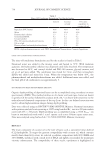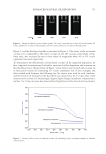669 MAPPING PROTEIN CROSS-LINKS IN HUMAN HAIR (11) D. A. Parry, L. N. Marekov, and P. M. Steinert, Subfilamentous protofibril structures in fibrous proteins: cross-linking evidence for protofibrils in intermediate filaments, J. Biol. Chem., 276(42), 39253–39258 (2001). (12) D. A. Parry, L. N. Marekov, P. M. Steinert, and T. A. Smith, A role for the 1A and L1 rod domain segments in head domain organization and function of intermediate filaments: structural analysis of trichocyte keratin, J. Struct. Biol., 137(1–2), 97–108 (2002). (13) R. D. Fraser and D. A. Parry , Structural changes in the trichocyte intermediate filaments accompanying the transition from the reduced to the oxidized form, J. Struct. Biol., 159(1), 36–45 (2007). (14) D. A. Parry and P. M. Steinert, Intermediate filaments: molecular architecture, assembly, dynamics and polymorphism, Q. Rev. Biophys., 32(2), 99–187 (1999). (15) P. M. Steinert, L. N. Marekov, R. D. Fraser, and D. A. Parry, Keratin intermediate filament structure. crosslinking studies yield quantitative information on molecular dimensions and mechanism of assembly, J. Mol. Biol., 230(2), 436–452 (1993). (16) H. Wang, D. A. Parry, L. N. Jones, W. W. Idler, L. N. Marekov, and P. M. Steinert, In vitro assembly and structure of trichocyte keratin intermediate filaments: a novel role for stabilization by disulfide bonding, J. Cell Biol., 151(7), 1459–1468 (2000).
670 Address all correspondence to Trefor Evans, tevans@triprinceton.org The Matrix Revisited S. BREAKSPEAR, TREFOR EVANS, B. NOECKER AND C. POPESCU KAO European Research Laboratories, KAO Germany GmbH, Darmstadt, Germany (S.B., B.N., C.P.) TRI Princeton, Princeton, New Jersey, USA (T.E.) Synopsis Feughelman’s two-phase model for keratin fibers provides a means for conceptualizing the properties and roles of differing protein structures within hair. Specifically, the crystalline α-helical keratin proteins that constitute the intermediate filaments/microfibrils are impenetrable to water, whereas the amorphous keratin within the surrounding matrix/keratin-associated protein is readily infiltrated. The presence of water solvates electrostatic bonding and progressively diminishes the contribution of the matrix protein through plasticization. In short, the wet-state mechanical properties of the fiber become dependent solely on the microfibrils, whereas in the dry state, the matrix also contributes to the structural integrity. In the hair care industry, there is a much higher tendency to perform hair testing in the wet state (e.g., wet-state instrumental combing, wet tensile testing, and even wet-state differential scanning calorimetry) however, such measurements contain no information about the amorphous matrix. Tensile experiments performed in the dry state show that the Young’s modulus can be two to three times higher than in the wet state, so clearly, the matrix can have a sizable contribution to fiber properties. The negative effects of various chemical treatments are well documented in wet-state tensile experiments, but dry-state testing can present anomalies. In particular, it is common to see the dry-state modulus increase after such treatments. It is worth emphasizing that this overall rise in modulus occurs even though the microfibril contribution is diminished. This suggests an enhanced matrix contribution that, in some cases, can be very sizable. This article presents a review of the literature focusing on how the matrix structure is described, in an effort to understand the contribution of the matrix to fiber properties. These ideas are supplemented with the authors’ experimental data to illustrate pertinent points and highlight some nontraditional outcomes and ideas. BACKGROUND Hair, the protective keratin fiber of mammal skin, is a focus for many researchers, because it offers hints into the world of biology and proteins and its unique composite architecture inspires material scientists. Its maintenance is also at the heart of a multibillion-dollar cosmetic industry. Morphologically, hair can be described as a multicellular tissue consisting of several structural components: the cortex, made of spindle-like cortical cells potentially a medulla, representing a core channel-like structure and a cuticle layer that wraps the whole ensemble with sheets of rectangular cells. Each component plays a role in the overall properties of keratin fibers, with the cortex being primarily responsible for the mechanical attributes of strength and rigidity. J. Cosmet. Sci., 72, 670–686 (November/December 2021)
Purchased for the exclusive use of nofirst nolast (unknown) From: SCC Media Library & Resource Center (library.scconline.org)






































































































































